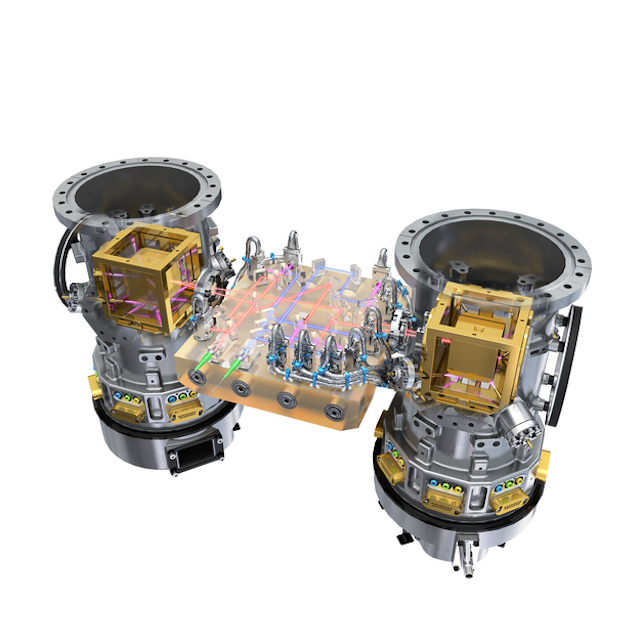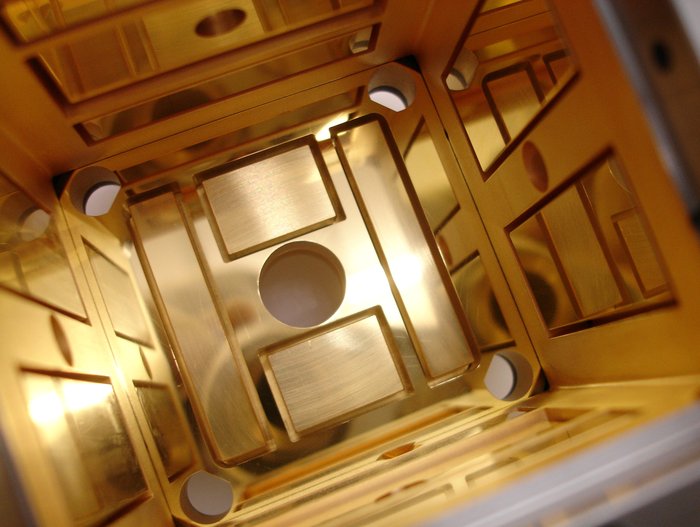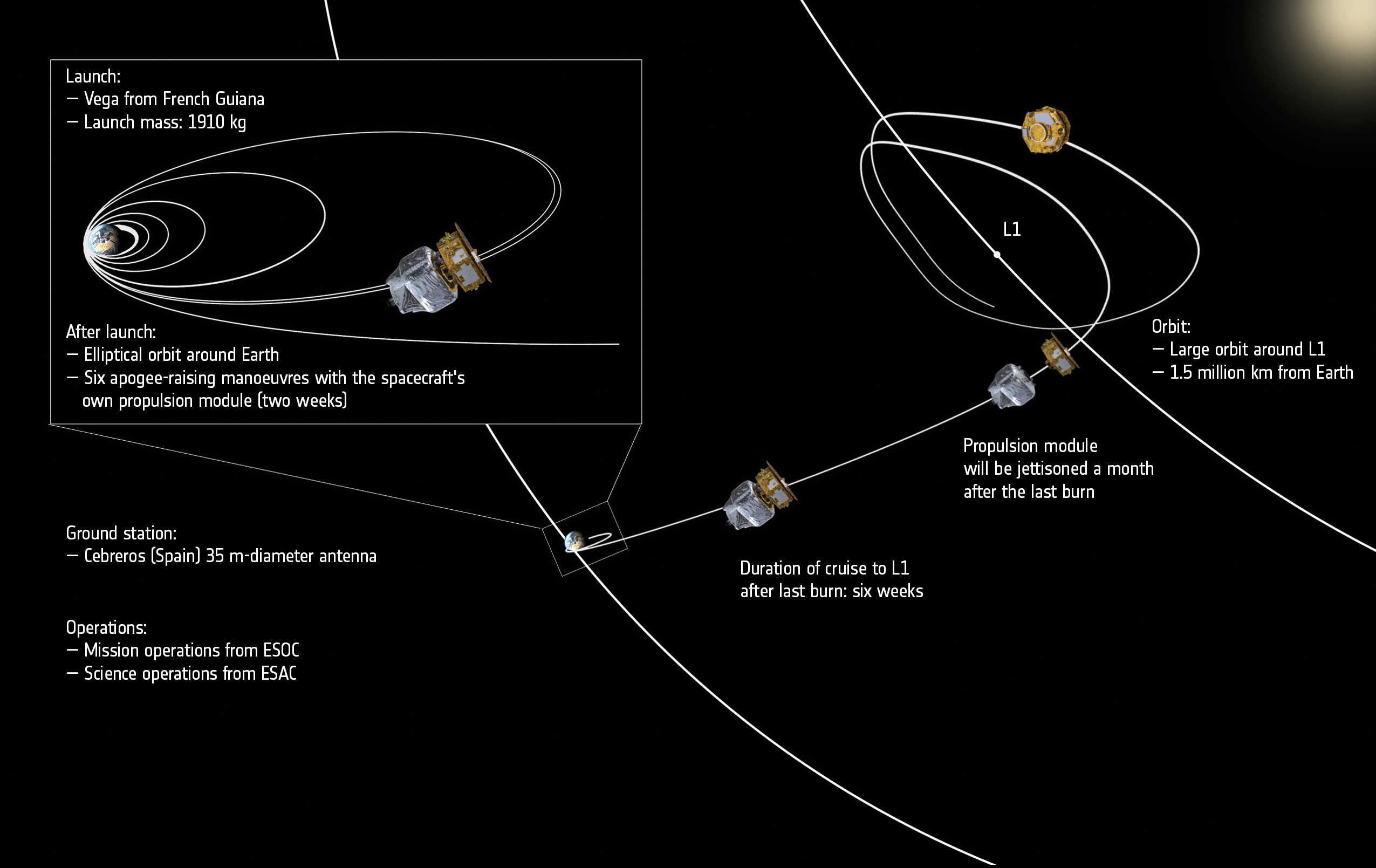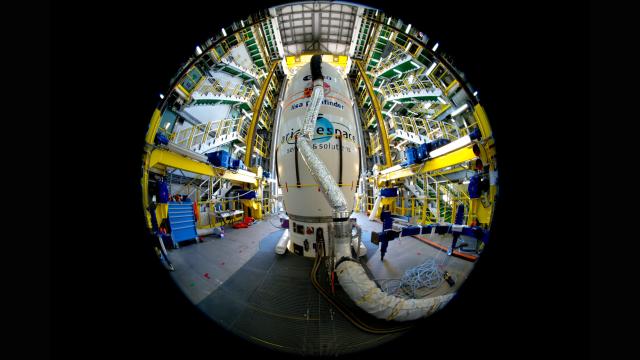A remarkable scientific experiment is about to leave Earth on a six week journey that will end a million kilometres away. The LISA Pathfinder marks the beginning of humanity’s outer space hunt for the elusive gravitational waves first predicted by Albert Einstein a century ago.
Gravitational waves are ripples in the fabric of spacetime caused by the most energetic events in the universe — supernovae, black hole mergers, and the like. Unlike electromagnetic radiation, which is scattered and distorted by matter, gravitational waves penetrate everything without being affected, thus offering window into otherwise inscrutable cosmic phenomena.
“Gravitational waves are the most direct way of studying the large fraction of the universe which is dark,” LISA Pathfinder project scientist Bill Weber told Gizmodo in a phone interview. “Black holes, neutron stars, and other objects that don’t emit light sound exotic, but they are believed to be a rather typical destiny for stars in the sky.”
Einstein’s spacetime ripples are also intriguing to physicists who want to understand how the force of gravity operates under extreme conditions. “You could imagine objects in orbit around each other at speeds approaching that of light,” Weber continued. “There’s a lot we haven’t tested about gravity in this regime of very strong gravitational fields.”
There’s just one problem: the signatures of gravitational waves are extremely faint. Imagine receiving the slightest of pushes, your position changing by a millionth of a millimetre. You wouldn’t notice the difference at all, but that’s the sort of force physicists are trying to detect. As you might imagine, our bustling, crowded planet isn’t exactly the ideal laboratory.

Computer model of the LISA pathfinder experimental chambers (gold boxes) and laser interferometer system (center). Image Credit: ESA
“Getting away from the Earth, you get away from the noisy gravitational field due to the motion of the oceans and the atmosphere and the vibrating Earth and cars,” Weber said.
What’s more, freed from the spatial constraints of a small planet, we can set up some seriously ambitious experiments. “The gravitational wave detectors we build on ground are limited in their sensitivity at a few Hz by the gravitational noise of the Earth and the ability to build detectors of the requisite length, LISA Pathfinder data analyst Martin Hewitson told Gizmodo in an email. “In space, no such restrictions apply.”
So space is exactly where we’re going.
This week, the European Space Agency will launch the LISA Pathfinder, a prototype observatory to test technologies needed for gravitational wave detection. Its goal is simple: using laser interferometers, the spacecraft will attempt to precisely measure the relative positions of two 3cm gold-platinum cubes in free fall. Housed in separate electrode boxes a mere 38cm apart, the test objects will be shielded from the solar wind and all other external forces, such that the tiny motions caused by gravitational waves can (hopefully) be detected.

LISA Pathfinder’s electrode housing chambers, where the positions of test masses will be precisely monitored. Image credit: CGS SpA
We won’t actually see gravitational waves with LISA Pathfinder — the experiment is too small. Rather, as Weber puts it, “we will demonstrate that you can make measurements of the relative position of two test objects at very high precision.” We’re gunning for a hundred millionth of a millimetre.
Eventually, the ESA plans to build a large space-based observatory that takes precise measurements on test objects separated by hundreds of thousands of kilometres. On those sorts of scales, we could cast a much wider net, measuring gravitational waves down to the millihertz range. “At these frequencies, there is expected to be a wealth of astrophysical and cosmological sources, providing us with signals from some of the most violent and massive events in the universe,” Hewitson said.

Trajectory of the LISA Pathfinder spacecraft. Image Credit: ESA
The LISA Pathfinder is set to launch on a Vega rocket from Europe’s spaceport in Kourou, French Guiana. (The launch was planned for yesterday, delayed due to a technical issue, and is now set for Thursday morning at 5:04am CET, 3:04pm AEDT.) After entering low Earth orbit, the spacecraft will separate from the rocket’s final stage and begin transmitting its first signals to the ground.
Over the next two weeks, the craft will undergo a series of orbit-raising maneuvers, propelling it on a six week journey to the L1 Lagrange point, a position of stable orbit between the Sun and Earth’s gravitational pull. By early March, LISA Pathfinder should be ready to start taking measurements. Its science team will spend several months conducting tests to understand limits on the laboratory’s measurement precision, including stray electrostatic forces, cosmic rays, and — literally — the random motion of molecules within the test masses themselves.
“There’s a whole series of physics of small force measurements that we want to investigate so we can turn around to ESA and say, ‘this works, these are the physical effects that limit us, and we’ve quantitatively studied them,’” Weber said. “If LISA Pathfinder is successful, that’s a really important milestone.”
Top: LISA Pathfinder, ready for launch, via ESA
